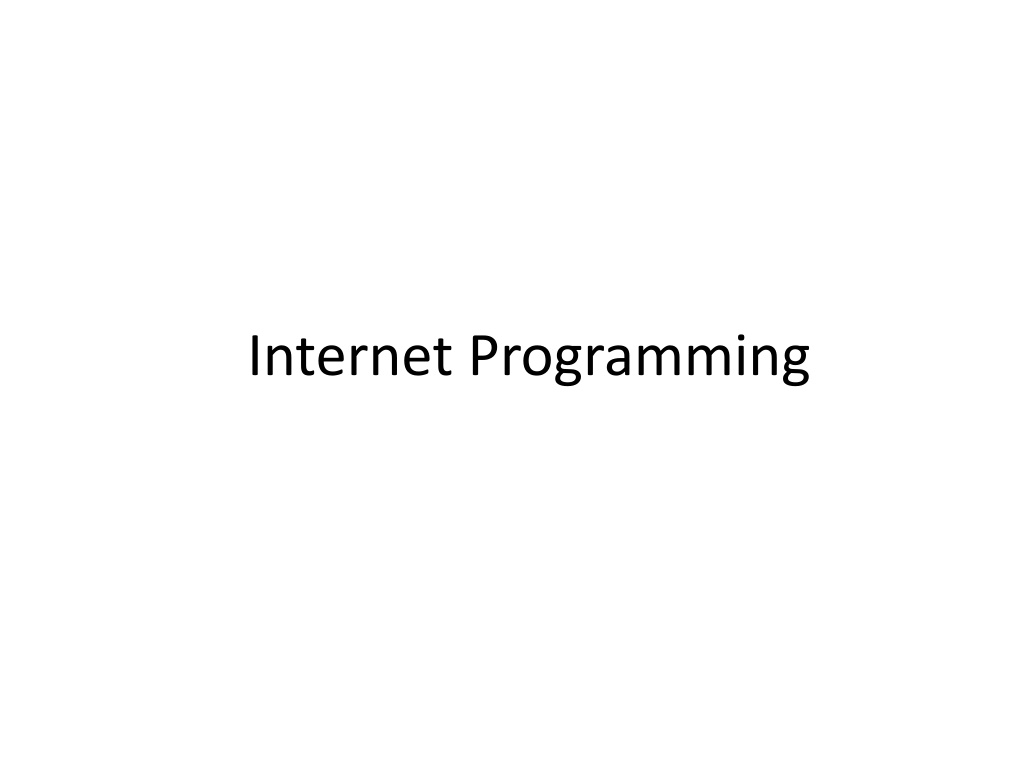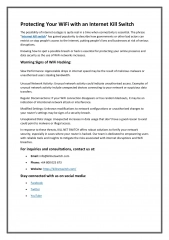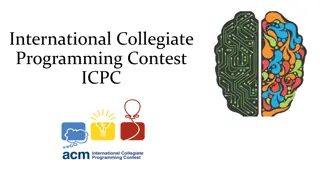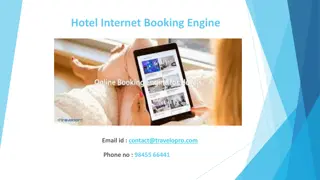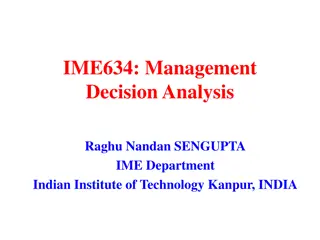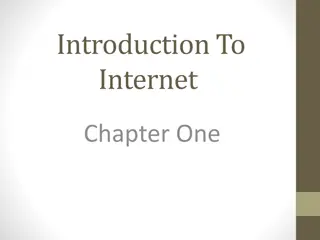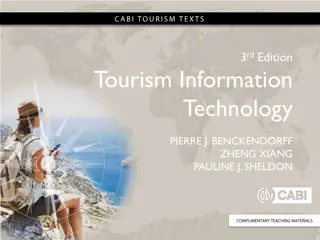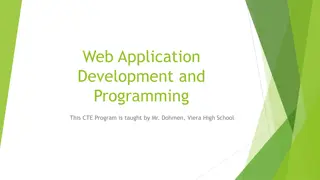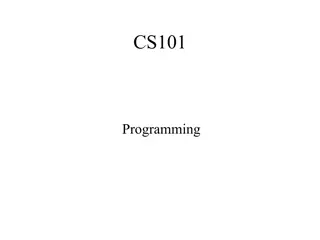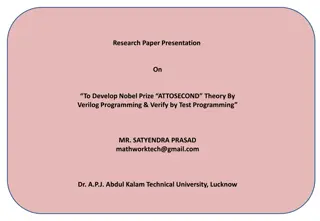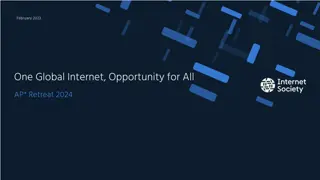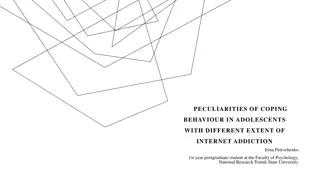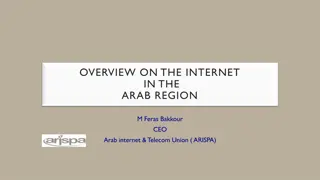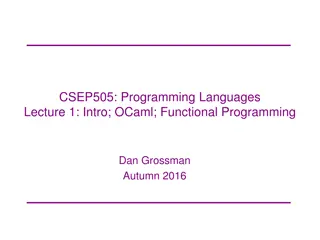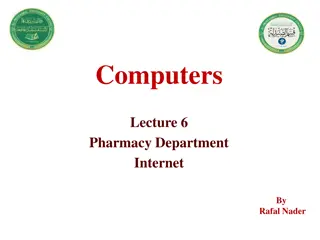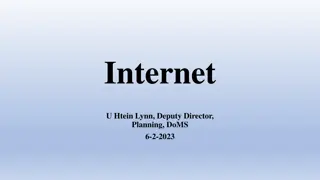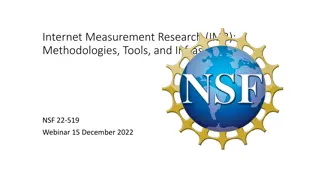Internet Programming
Acquire foundations of HTML, CSS, Servlets, and Java Server Pages for designing interactive dynamic web pages. Covers web page creation using various technologies such as JavaScript, Java, and MYSQL database.
Download Presentation

Please find below an Image/Link to download the presentation.
The content on the website is provided AS IS for your information and personal use only. It may not be sold, licensed, or shared on other websites without obtaining consent from the author.If you encounter any issues during the download, it is possible that the publisher has removed the file from their server.
You are allowed to download the files provided on this website for personal or commercial use, subject to the condition that they are used lawfully. All files are the property of their respective owners.
The content on the website is provided AS IS for your information and personal use only. It may not be sold, licensed, or shared on other websites without obtaining consent from the author.
E N D
Presentation Transcript
Course Overview Course Name Course Code L-T-P structure Course Credits Course Coordinator : INTERNET PROGRAMMING : 11EM3O1 : 3-0-2 : 4 : Dr.M.KAMESWARA RAO : Dr.M.KAMESWARA RAO, Dr.D.B.K.KAMESH, Dr.K.V.D.SAGAR, Mrs.P.S.G.ARUNA SRI, Mrs.SHAHANA BANO, Dr.K.RAVINDRANADTH, Mr.V.VIJAY KUMAR Course Instructors
Course Objective The Objective of the course is to enable the students to acquire foundations of the technologies like HTML, CSS, Servlets and Java Server Pages for design and development of interactive dynamic web pages.
Course Outcomes CO No: CO SO BTL CO1 Create web pages using HTML, CSS and Javascript. k 3 CO2 Apply object oriented programming features in Java to solve computing problems. Create dynamic web pages using Java Servlets and JDBC. a,k 2 CO3 k 3 CO4 Create dynamic web pages using Java Server pages and MYSQL database. Create simple web based applications using HTML, CSS, JSP and MYSQL. k 3 CO5 K 3
COURSE OUTCOME INDICATORS (COI): CO No. COI-1 COI-2 COI-3 CO1 Create a set of interlinked web pages using basic HTML tags related to text, Image, hyperlink, list ,iframe, table and form related elements. Apply inline/ internal/ external CSS to change the look and feel (style) of web pages. Apply the basic concepts related to objects and event handling in DHTML to a web page. CO2 Apply programming Encapsulation, polymorphism in java to solve various computing problems. the basic object features Inheritance oriented Apply the concepts related to packages, exception handling and multithreading in java to solve computing problems. Apply the concepts related to I/O streams and applets in java to solve computing problems. like and CO3 Understand the need of Servlets, Servlet architecture, methods and basic constructs. Create dynamic web pages and process form HttpServlets Create establish database to read /send data using JDBC. servlet connection scripts that life cycle data using with a programming CO4 Create JSP scripts using basic scripting elements and directive elements. Create JSP scripts to process data sent via HTML forms Create /receive data to/from MYSQL database. JSP scripts to send CO5 Design and develop a web based application using HTML, CSS, JSP and MYSQL.
Syllabus HTML, DHTML, Cascading Style sheets, XML. A closure look at Methods and classes, Inheritance, Packages, and Exception handling. Multithreaded programming, I/O, Applets and other topics, the Applet class, Event handling. Servlets and java server pages, data access through the web. Architecture for database access, the My SQL database system, database access with JDBC and MySQL
Evaluation Component COI Number BTL Test 1 CO II CO III CO IV CO V Weightage/Marks CO I 1 2 3 1 2 3 1 2 3 1 2 3 Duration (Hours) 1.5 Date Weightage (%) 7.5 7.5 10 10 10 Max Marks (30) Weightage (%) 7.5 Test 2 1.5 7.5 1 0 1 0 10 Max Marks (30) Weightage (%) 7.5 Max Marks (30) Weightage (%) 7.5 Test 3 1.5 7.5 10 10 10 LTC 7.5 30 Max Marks (30) Attendance Equal weightagefor all the lecture sessions (5 %) Weightage (5%) Lab Experiment 5% Weightage (5%) Semester End Project 10% Weightage (%) 10 Max Marks () Semester End Lab 5% Weightage (%) 5 Max Marks () Semester End Exam 3 Weightage (45 %) Max Marks (60) Question Number
History of Web The World Wide Web ("WWW" or simply the "Web") is a global information medium which users can read and write via computers connected to the Internet. Tim Berners-Lee HyperText Transfer Protocol (HTTP) HyperText Markup Language(HTML), the first Web browser (named WorldWideWeb, which was also a Web editor), the first web server (http://info.cern.ch)
List of Browsers WorldWideWeb, February 26, 1991 Mosaic, April 22, 1993 Netscape Navigator and Netscape Communicator, October 13, 1994 Internet Explorer, August 16, 1995 Opera, 1996, see History of the Opera web browser Mozilla Navigator, June 5, 2002[19] Safari, January 7, 2003 Mozilla Firefox, November 9, 2004 Google Chrome, September 2, 2008 Etc
Hypertext Markup Language Hypertext- contains links to other texts. Markup language- annotate a document's content to give information regarding the structure of the text or instructions for how it is to be displayed. Hypertext is text which a notation used to
HTML HTML is a language for describing web pages. HTML is a markup language A markup language is a set of tags The tags describe document content HTML documents contain HTML tags and plain text HTML documents are also called web pages
HTML Tags HTML markup tags are usually called HTML tags. HTML tags are keywords (tag names) surrounded by angle brackets like <html> HTML tags normally come in pairs like <p> and </p> The first tag in a pair is the start tag, the second tag is the end tag The end tag is written like the start tag, with a slash before the tag name Start and end tags are also called opening tags and closing tags Example : <tagname>content</tagname>
HTML Tags HTML is a language of mark-up tags in angle brackets: <> <html> </html> (Required!) Basic tag to identify portion of file that contains HTML <html> is an opening tag </html> is a closing tag (note the direction of the slash!) text between the opening and closing tag is called the element <head> </head> (Required!) placed at the top of document immediately after the <html> tag tags information about the document, e.g. author, style, etc. contains the required document <title>...</title> tag
HTML Required Tags <title> </title> (Required!) included as an element inside the <head> </head> section element of this tag is the title displayed in title bar of the browser may also be used as title of page when page is bookmarked should be meaningful and uniquely identify the page <body> </body> (Required!) included as the second element inside the <html> </html> tags. follows the <head> </head> portion of the document contains the information to be displayed in the browser window any attributes set on this tag will apply to the entire page 25
HTML Elements In HTML, most elements are written with a start tag (e.g. <p>) and an end tag (e.g. </p>), with the content in between: Example : <p>This is a paragraph.</p>
HTML Editors An HTML editor is a computer program for creating web pages HTML can be edited by using a professional HTML editor like: Adobe Dreamweaver Microsoft Expression Web CoffeeCup HTML Editor text editor like Notepad etc http://www.skilledup.com/learn/programming/best- html-editors/
HTML TAGS DEMO
